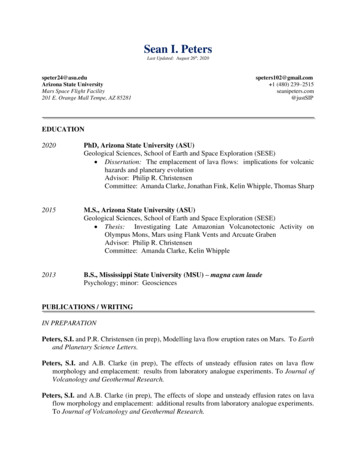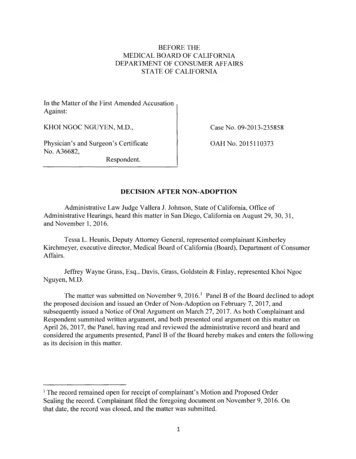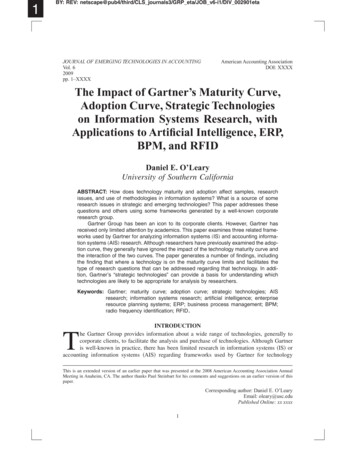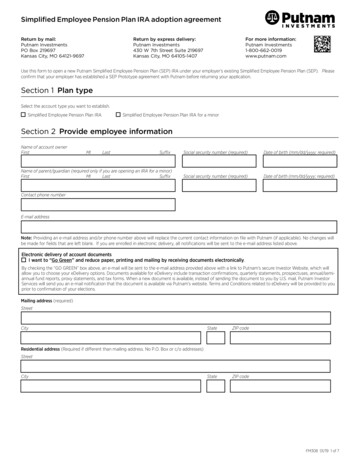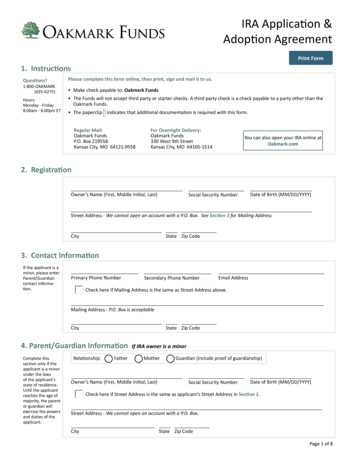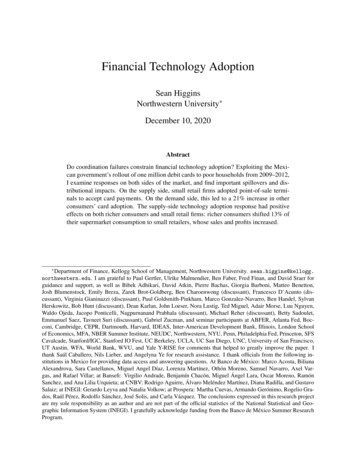
Transcription
Financial Technology AdoptionSean HigginsNorthwestern University December 10, 2020AbstractDo coordination failures constrain financial technology adoption? Exploiting the Mexican government’s rollout of one million debit cards to poor households from 2009–2012,I examine responses on both sides of the market, and find important spillovers and distributional impacts. On the supply side, small retail firms adopted point-of-sale terminals to accept card payments. On the demand side, this led to a 21% increase in otherconsumers’ card adoption. The supply-side technology adoption response had positiveeffects on both richer consumers and small retail firms: richer consumers shifted 13% oftheir supermarket consumption to small retailers, whose sales and profits increased.Department of Finance, Kellogg School of Management, Northwestern University. sean.higgins@kellogg.northwestern.edu. I am grateful to Paul Gertler, Ulrike Malmendier, Ben Faber, Fred Finan, and David Sraer forguidance and support, as well as Bibek Adhikari, David Atkin, Pierre Bachas, Giorgia Barboni, Matteo Benetton,Josh Blumenstock, Emily Breza, Zarek Brot-Goldberg, Ben Charoenwong (discussant), Francesco D’Acunto (discussant), Virginia Gianinazzi (discussant), Paul Goldsmith-Pinkham, Marco Gonzalez-Navarro, Ben Handel, SylvanHerskowitz, Bob Hunt (discussant), Dean Karlan, John Loeser, Nora Lustig, Ted Miguel, Adair Morse, Luu Nguyen,Waldo Ojeda, Jacopo Ponticelli, Nagpurnanand Prabhala (discussant), Michael Reher (discussant), Betty Sadoulet,Emmanuel Saez, Tavneet Suri (discussant), Gabriel Zucman, and seminar participants at ABFER, Atlanta Fed, Bocconi, Cambridge, CEPR, Dartmouth, Harvard, IDEAS, Inter-American Development Bank, Illinois, London Schoolof Economics, MFA, NBER Summer Institute, NEUDC, Northwestern, NYU, Penn, Philadelphia Fed, Princeton, SFSCavalcade, Stanford/IGC, Stanford IO Fest, UC Berkeley, UCLA, UC San Diego, UNC, University of San Francisco,UT Austin, WFA, World Bank, WVU, and Yale Y-RISE for comments that helped to greatly improve the paper. Ithank Saúl Caballero, Nils Lieber, and Angelyna Ye for research assistance. I thank officials from the following institutions in Mexico for providing data access and answering questions. At Banco de México: Marco Acosta, BilianaAlexandrova, Sara Castellanos, Miguel Angel Díaz, Lorenza Martínez, Othón Moreno, Samuel Navarro, Axel Vargas, and Rafael Villar; at Bansefi: Virgilio Andrade, Benjamín Chacón, Miguel Ángel Lara, Oscar Moreno, RamónSanchez, and Ana Lilia Urquieta; at CNBV: Rodrigo Aguirre, Álvaro Meléndez Martínez, Diana Radilla, and GustavoSalaiz; at INEGI: Gerardo Leyva and Natalia Volkow; at Prospera: Martha Cuevas, Armando Gerónimo, Rogelio Grados, Raúl Pérez, Rodolfo Sánchez, José Solis, and Carla Vázquez. The conclusions expressed in this research projectare my sole responsibility as an author and are not part of the official statistics of the National Statistical and Geographic Information System (INEGI). I gratefully acknowledge funding from the Banco de México Summer ResearchProgram.
1IntroductionNew financial technologies are rapidly changing the way that households shop, save, borrow, andmake other financial decisions. Payment technologies like debit cards and mobile money—whichenable consumers to make retail payments and transfers through a bank account or mobile phone—can benefit both consumers and retail firms (Jack and Suri, 2014; Agarwal et al., 2020). Becausepayment technologies feature two-sided markets, however, coordination failures can constrainadoption. Two-sided markets generate indirect network externalities, where the benefits a debitcard user derives from the technology depend on supply-side adoption of technology to acceptcard payments, which in turn depends on how many other consumers have adopted debit cards.1These indirect network externalities can lead to multiple adoption equilibria, where moving to thePareto-dominating equilibrium requires coordination (Katz and Shapiro, 1986; Gowrisankaran andStavins, 2004).The magnitude of these externalities and resulting spillovers of financial technology adoptionwithin and across the two sides of the market have been difficult to study for three main reasons.First, technology adoption is typically endogenous. Second, because supply-side adoption of thecorresponding technology could require consumer adoption to reach a certain threshold beforeretailer adoption is optimal, any exogenous shock to consumer adoption would need to be largeand coordinated within the local market. Third, quantifying indirect network externalities withinone side of the market requires a shock that directly affects only a subset of consumers (or firms),ruling out large-scale adoption subsidies that affect an entire side of the market.I exploit large localized shocks to consumers’ adoption of a particular payment technology—debit cards—to trace out the supply and demand-side spillovers of coordinated technology adoption in a two-sided market. Between 2009 and 2012, the Mexican government disbursed aboutone million debit cards as the new payment method for its large-scale conditional cash transferprogram, Prospera. I find that small retailers responded to these large local shocks to consumerdebit card adoption by adopting point-of-sale (POS) terminals to accept card payments, while largeretailers such as supermarkets already had near-universal adoption of POS terminals. I then examine how this supply-side response fed back to the demand side, finding that it led to an increase inother consumers’ debit card adoption and a partial shift in richer households’ consumption fromlarge to small retailers now that they could use debit cards at more small retailers. Consistentwith this shift in consumption, I find that small retailers’ sales and profits increased, while large1 Katzand Shapiro (1985) distinguish indirect network externalities—which arise in two-sided markets—fromdirect network externalities. A direct network externality arises from a product such as the telephone, where usersbenefit directly from other consumers’ adoption of the technology. An indirect network externality arises from twosided markets: a debit card user does not benefit directly from other consumers’ adoption of debit cards, but ratherthrough the effect of other consumers’ adoption of cards on the probability that retailers adopt technology to acceptcard payments.1
retailers’ sales decreased.The government’s rollout of debit cards to cash transfer recipients has a number of notable features that make it ideal for tracing out the supply and demand-side responses to a shock to financialtechnology adoption. First, the shock was large within the local market: in the median treated locality, it directly increased the proportion of households with a debit card by 18 percentage points(48%) in one week.2 Second, the shock only reduced the cost of debit card adoption for a subset ofconsumers (specifically, beneficiaries of Mexico’s cash transfer program), which allows me to isolate spillover effects on other consumers whose cost of adoption did not change. Third, the shockcreated plausibly exogenous variation over time and space in debit card adoption: it occurred indifferent localities at different points in time and was uncorrelated with levels and pre-treatmenttrends in financial infrastructure and other locality characteristics.An additional challenge to studying the network externalities and spillovers of financial technology adoption is that in most empirical settings there is a lack of high-quality data on firms’technology adoption and on outcomes for both firms and other consumers. To overcome this barrier, I combine administrative data from Prospera on the debit card rollout with a rich collection ofseven additional data sets on both consumers and retailers. The key data set on supply-side financial technology adoption is a confidential data set on the universe of POS terminal adoptions byretailers over a twelve-year period, accessed on-site at Mexico’s Central Bank. For spillovers onother consumers, the two key data sets that I use are quarterly data on the number of debit cards atthe bank by municipality level and a nationally representative consumption survey that can be usedto identify unique trips to different types of stores. I complement these with four additional confidential data sets: transaction-level data on the universe of debit and credit card transactions at POSterminals over eight years; transaction-level data from the bank accounts of Prospera beneficiaries;a panel on store-level sales, costs, and profits for the universe of retailers; and high-frequency pricedata at the store by barcode level from a sample of stores.Small retail firms responded to the shock to consumer debit card adoption by adopting POSterminals to accept card payments. Exploiting the gradual rollout of debit cards over time, I findthat the number of corner stores with POS terminals increased by 3% during the two-month periodin which the shock occurred.3 Adoption continued to increase over time: two years after the shock,18% more corner stores had adopted POS terminals in treated localities (relative to localities thathad yet to be treated). There is no effect among supermarkets, which already had high levels ofPOS adoption prior to the shock.The shock to consumer card adoption and subsequent adoption of POS terminals by small2 In the median treated locality, 36% of households had a debit or credit card prior to the shock (based on householdsurvey data), and the shock increased the proportion of households with a card to 54%.3 Administrative data from Bansefi, the government bank that administers cash transfer beneficiaries’ accounts,show that cards were usually distributed during the first week of these two-month periods.2
retailers had spillover effects on other consumers’ card adoption. Using data on the total numberof debit cards issued by banks other than the government bank that administered cards to cashtransfer recipients, I find that other consumers responded to the increase in financial technologyadoption by increasing their adoption of debit cards. Specifically, 3–6 months after the shockoccurred, the number of cards held by other consumers increased by 19%. Two years after theshock, 28% more consumers had adopted cards. Combining the large direct shock to debit cardadoption and its spillover effect on other consumers’ adoption, debit card adoption in the mediantreated locality increased from 36% to 63% in just one year; for comparison, in the absence of alarge, coordinated shock it took China and the United States each about six years to achieve similarincreases in debit card adoption.4The adoption of POS terminals by small retailers also affected where consumers shopped. Therichest quintile of all consumers—who were substantially more likely to have cards before theshock—substituted about 13% of their total supermarket consumption to corner stores after theincreased POS adoption by corner stores. This is at least partly driven by a change in the numberof trips to supermarkets and corner stores: households in the richest quintile made, on average, 0.2fewer trips per week to supermarkets and 0.8 more trips per week to corner stores after the shock(relative to households in the same income quintile in not-yet-treated localities). While these shiftsin consumption across store types occurred only for richer consumers (not Prospera beneficiaries),a companion paper looks at the effect of the debit cards on beneficiaries’ income, consumption,and savings (Bachas, Gertler, Higgins and Seira, forthcoming).5To estimate the effects of POS terminal adoption on small retailers, I use data on the revenuesand costs of the universe of retailers in Mexico. Over the five-year period between survey rounds,corner store sales increased by 6% more in earlier-treated localities. Corner stores increased theamount of inventory they bought and sold without increasing other input costs such as wages, number of employees, rent, capital, or utilities, which led to an increase in their profits. This does notrepresent an aggregate gain for retailers, however, as increased corner store sales were accompanied by decreased supermarket sales that are very similar in aggregate magnitude. The shift insales from supermarkets to corner stores has distributional implications, as corner stores are substantially smaller than supermarkets and corner store owners are lower in the income distribution4 InChina, debit card adoption increased from 41% in 2011 to 67% in 2017 (Demirgüç-Kunt et al., 2018). In theUS, adoption increased from 34% in 1998 to 59% in 2004 (Mester, 2009). I assume that debit cards adopted fromother banks were adopted by other consumers rather than by Prospera beneficiaries and their household members; thisassumption is supported by survey data, which show that Prospera households did not adopt cards from other banks(Section 5.2).5 In that paper, we find that the cards did not affect beneficiaries’ income, but that beneficiaries did begin savingmore in the bank after receiving cards. Furthermore, this increase in formal savings represents an increase in overallsavings, financed by a voluntary reduction in current consumption. Consistent with those findings, using a differentdata set in this paper I also find evidence of a reduction in overall consumption by Prospera beneficiaries as a result ofreceiving a debit card.3
than supermarket owners.Finally, to quantify the magnitude of the indirect network externalities, I use a simple theoretical framework to estimate the fraction of consumer welfare gains from the shock-inducedsupply-side POS adoption that accrued to consumers who did not directly receive debit cards fromthe government. I combine consumption survey microdata on consumer choices across store typesand prices with data on POS adoption and the geocoordinates of all retailers. My estimating equation is derived from a discrete–continuous choice model where consumers decide, for each shopping trip, which store to go to and how much of each good to purchase. Empirically, supermarketsare farther than corner stores on average and charge more for identical products, but accept cardpayments and offer other amenities. Corner stores, on the other hand, may or may not accept cardpayments. Using the coefficients from this demand model, I estimate the price-index-equivalentconsumer gains resulting from the shock-induced change in the proportion of corner stores accepting cards. Over half of the consumer welfare gains were spillovers to existing card holders and tonon-beneficiaries who adopted cards as a result of the shock, which implies that indirect networkexternalities were large. Furthermore, the aggregate welfare value of the spillovers in the first twoyears was 37 times as large as the aggregate costs incurred by the Mexican government to providedebit cards.This paper makes two main contributions. First, by combining large local shocks and severalrich sources of confidential microdata on consumers and retailers, I am able to trace out how shocksto consumers’ financial technology adoption filtered through markets to affect retail adoption offinancial technology, as well as how this supply-side response spilled over onto other consumers’technology adoption and consumption across stores. Most research on the effects of financial technologies, on the other hand, has focused on direct effects for households who adopt (e.g., Dupasand Robinson, 2013; Schaner, 2017; Callen, de Mel, McIntosh and Woodruff, 2019; Breza, Kanzand Klapper, 2020) or on information spillovers across households (Banerjee, Chandrasekhar, Duflo and Jackson, 2013). Two closely related papers study the network effects of technology adoption. Jack and Suri (2014) find that mobile money increased households’ ability to share risk byreducing the transaction costs of transferring money. Björkegren (2019) uses rich data from mobile phone call records to quantify the network effects of mobile phone adoption in Rwanda. Bothof these papers focus on direct network externalities across households, whereas I study indirectnetwork externalities and coordination failures arising from a two-sided market.6Second, I quantify the distributional impacts for both households and retail firms of a largeincrease in poor households’ financial technology adoption: small retailers and richer consumers6Aset of papers on India’s demonetization also study both sides of financial technology markets (e.g., Agarwalet al., 2018; Crouzet, Gupta and Mezzanotti, 2020). Because demonetization had large direct impacts on both sides ofthe market and also directly impacted employment, output, and bank credit (Chodorow-Reich, Gopinath, Mishra andNarayanan, 2020), studies exploiting this shock do not isolate spillovers across the two sides of the market.4
benefited substantially from the shock, as richer consumers responded to small retailers’ adoptionof POS terminals by shifting part of their supermarket consumption to corner stores. This relatesto a growing literature on the distributional impacts of various shocks on retail firms throughoutthe firm size distribution, and on the households who shop at these retailers (Atkin, Faber andGonzalez-Navarro, 2018; Faber and Fally, forthcoming). Furthermore, this finding speaks to thepolitical economy of government policy to subsidize financial inclusion. Specifically, such spending may be politically popular given that it not only benefits poor households by reducing theirtransaction costs of saving (Bachas, Gertler, Higgins and Seira, forthcoming) and enabling them toshop with a debit card, but also through its effects on retailers’ financial technology adoption andthe resulting benefits for richer households.2Financial Technology Adoption in MexicoThe proportion of adults who do not have a debit card, credit card, or mobile money accountin Mexico is high, at 71%—compared to 50% worldwide (Demirgüç-Kunt et al., 2018). Theproportion of the population with a debit or credit card is also highly correlated with income,as shown in Figure 1a. In urban areas, 12% of households in the bottom income quintile had adebit or credit card prior to the Prospera debit card rollout, compared to 54% of households inthe top income quintile. On the supply side of the market, 32% of retailers in urban areas hadadopted POS terminals prior to the rollout, including 26% of corner stores and nearly 100% ofsupermarkets.Figure 1b shows the cross-sectional municipality-level correlation between adoption on eachside of the market: the y-axis shows the proportion of retailers with POS terminals, and the x-axisshows the number of debit cards per person.7 Each point on the graph is a municipality, and thesize of the points represents population. The evolution of card and POS terminal adoption overtime also appears highly correlated: Figure 2 shows the variation in adoption on each side of themarket across space and time. Comparing the change in adoption of debit cards and POS terminalsin particular municipalities over time (i.e., comparing the changes between panels a and b), it isclear that—descriptively—adoption of the technologies is correlated: the municipalities that hadlarge increases in debit card adoption also had large increases in POS terminal adoption.2.1Shock to Debit Card AdoptionBetween 2009 and 2012, the Mexican government rolled out debit cards to existing beneficiaries ofits conditional cash transfer program Prospera in urban localities, defined as localities with at least15,000 inhabitants. Prospera—formerly known as Progresa and later Oportunidades—is one of thefirst and largest conditional cash transfer programs worldwide, with a history of rigorous impact7Iuse the number of debit cards per person rather than the number of individuals with debit cards because thelatter is not available (except in household surveys
To estimate the effects of POS terminal adoption on small retailers, I use data on the revenues and costs of the universe of retailers in Mexico. Over the five-year period between survey rounds, corner store sales increased by 6% more in earlier-treated


